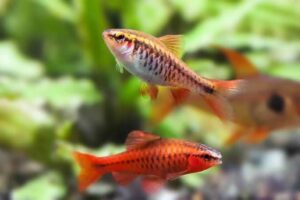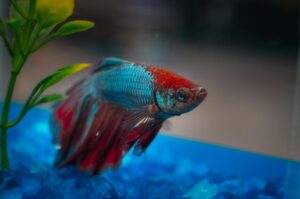Betta fish, also known as Siamese fighting fish, are among the most popular freshwater aquarium pets due to their vibrant colors, unique personalities, and relatively easy care. If you’re planning to own a betta fish or already have one, the betta fish tank setup is the most critical aspect of keeping your betta healthy and thriving.
In this ultimate guide, we’ll cover everything you need to know about setting up a betta fish tank, betta fish lifespan, different types of betta fish, their care, behavior, and how to ensure your betta lives a long, vibrant life.
What is a Betta Fish?
Betta fish are small, colorful, and territorial freshwater fish native to Southeast Asia. They are known for their aggressive nature—especially male betta fish, who will often fight other males if kept in the same tank. Despite this, bettas can live peacefully in the right conditions and make stunning solo pets.
Ideal Betta Fish Tank Setup
Why a Proper Betta Fish Tank is Important
Many people mistakenly believe betta fish can thrive in small bowls or vases. This is far from the truth. A well-equipped betta fish tank improves the fish’s lifespan, mood, and health.
Recommended Betta Fish Tank Size
- Minimum size: 5 gallons (19 liters)
- Bigger is better: More space equals better water conditions and mental stimulation
Essential Equipment
- Heater: Bettas are tropical fish; they need water temperatures between 76°F – 82°F (24°C – 28°C)
- Filter: Keeps the tank clean and reduces ammonia/nitrite build-up
- Thermometer: For monitoring water temperature
- Substrate: Gravel or sand
- Live or silk plants: Provide hiding spots and comfort
- Lid or cover: Bettas can jump!
Water Conditions
- pH level: 6.5 – 7.5
- Ammonia/Nitrite: 0 ppm
- Nitrate: Below 20 ppm
- Perform regular 25% water changes weekly
Betta Fish Lifespan: How Long Do Betta Fish Live?
When properly cared for, betta fish can live up to 3-5 years. Some even live longer in optimal conditions. Factors influencing lifespan include:
- Tank size and cleanliness
- Quality of food
- Genetic factors
- Stress levels
Types of Betta Fish
There are many types of betta fish categorized by tail shape, color, and patterns:
Common Tail Types:
- Halfmoon Betta Fish – 180° tail spread, fan-like tail
- Veiltail – Long, flowing downward tail
- Crowntail – Spiky tail rays
- Plakat – Short-tailed, fighter-like
- Double Tail – Two distinct tail lobes
Each type has its own appeal and care needs, but all require a similar betta fish tank setup.
Male Betta Fish vs Female Betta Fish
Male Betta Fish
- More colorful and have longer fins
- Highly territorial
- Should be kept solo unless breeding
Female Betta Fish
- Less aggressive
- Can be kept in sororities (groups) in larger tanks (20+ gallons)
- Smaller fins but still beautiful
Understanding the difference between male betta fish and female betta fish is vital before setting up your tank.
Color Varieties: Blue, Red, Purple, Pink Betta Fish
Betta fish are available in an impressive spectrum of colors. These are not just beautiful to look at but are often sought-after by collectors.
- Blue Betta Fish: One of the most common and stunning varieties
- Red Betta Fish: Bright and bold, signifies vitality
- Purple Betta Fish: Rare and regal, often mixed with other hues
- Pink Betta Fish: Very delicate and rare in appearance
These colors may shift slightly depending on lighting, diet, and mood.
Understanding Betta Fish Behavior Before Death
Recognizing the betta fish behavior before death is essential to take preventive action. Signs may include:
- Loss of color
- Clamped fins
- Reduced activity
- Floating on one side
- Labored breathing
- Not eating
In many cases, improving tank conditions and seeking timely treatment can reverse some of these signs.
Betta Fish Care Guide
1. Regular Water Changes
Replace 25% of the tank water weekly using dechlorinated water to keep toxins low.
2. Proper Temperature
Use an adjustable heater to maintain stable temperatures. Cold water can cause lethargy and diseases.
3. Enrichment
Provide hiding spots, floating logs, or mirrors (in moderation) to reduce boredom.
4. Tank Mates
Betta fish are not community fish by default. If you want tank mates:
- Use a 10-gallon or bigger tank
- Avoid fin-nipping species
- Consider snails, ghost shrimp, or small peaceful fish
Feeding Your Betta: Betta Fish Food
Bettas are carnivorous. Proper betta fish food includes:
- High-protein betta pellets
- Freeze-dried bloodworms
- Brine shrimp
- Daphnia
Feeding Tips:
- Feed 1-2 times daily
- Only give what they can consume in 2 minutes
- Fast once a week to avoid bloating
Where to Buy: Petco Betta Fish and Other Sources
Petco betta fish are readily available and come in various types and colors. However, always inspect the fish before purchase:
- Look for clear eyes, active swimming, and vibrant color
- Avoid bettas in dirty water or with damaged fins
Other Buying Options:
- Local fish stores
- Online specialty breeders (for rare types like purple betta fish or halfmoon betta fish)
- Aquarium expos or betta fish shows
FAQs on Betta Fish and Betta Fish Tank
Q1: Can betta fish live in a bowl?
No. A bowl is too small and doesn’t allow for filtration or proper heating. Bettas need at least a 5-gallon tank.
Q2: How often should I clean a betta fish tank?
Weekly water changes (25%) and monthly deep cleanings (vacuuming substrate, cleaning decor) are ideal.
Q3: Can two betta fish live together?
Two male bettas should never be housed together. Some female bettas can live in groups (sororities) with caution.
Q4: What is the best filter for a betta fish tank?
A sponge filter or a gentle flow filter is ideal to avoid stressing their delicate fins.
Q5: Do betta fish get lonely?
Betta fish are solitary creatures and generally do not need companionship to be happy.
Conclusion
Setting up the perfect betta fish tank is the first and most important step toward keeping your betta healthy, active, and beautiful. With proper care, the right tank environment, and a regular feeding routine, your betta fish can thrive and live a long life.
Whether you prefer a blue betta fish, a majestic halfmoon, or a rare pink betta fish, they all deserve a comfortable and clean home. Consider all aspects—tank size, temperature, food, and behavioral signs—to become a responsible and loving betta owner.



Pingback: How Long Do Betta Fish Live? A Complete Lifespan & Care Guide